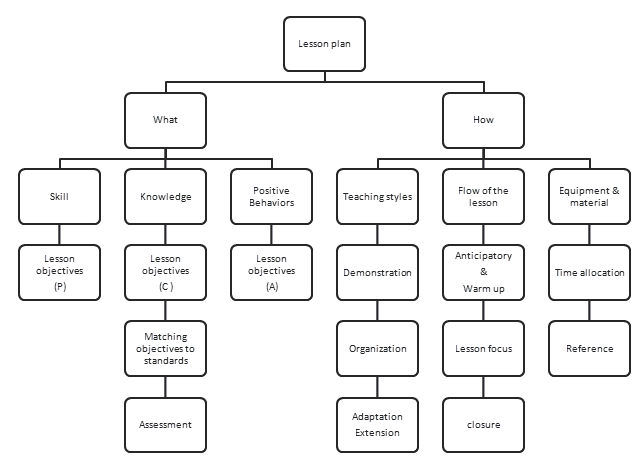 The
Thinking Process of Planning a Quality Lesson The
Thinking Process of Planning a Quality Lesson
written by by Wei
(Willa) Bian, associate professor, Slippery Rock University
"If you fail to plan, plan to
fail."
The Lesson plan is one of
the most important steps for teachers in order to provide
a quality education experience to their students. At the beginning
of each semester, many student teachers are heading to schools
to practice what they have learned in the field. For those
novice teachers, developing a good lesson plan is crucial
to a successful lesson. As a new teacher, you may wonder where
to begin, and what you should do to plan your lesson.
Figure 1 is a flow chart that shows
the thinking process when planning a lesson. It may not cover
every element that is necessary for a thorough lesson plan,
but we hope this chart will serve as a map to guide you when
planning a quality lesson.
Figure 1: The Flow Chart of Thinking Process for a Quality
Lesson in Physical Education

Plan for what you are going to teach
There are two major things you need to consider when starting
to plan a lesson: What you teach, and how to
teach it.
The First part is 'what you are going to teach,' which is
more related to your content knowledge. Under this category,
you need to first set up lesson objectives in the following
educational domains: Psychomotor (P), cognitive (C) and affective
(A).
Psychomotor domain refers
to movement patterns, sport skills, or fitness components
that your students need to develop. This part usually serves
as the lesson focus, since the key to physical education is
body movement. You must clearly know the movement skills or
fitness components that you expect your students to learn
or to review in your lesson. Write down at least one or two
lesson objectives in the psychomotor domain.
For example, if you want your students to learn how to throw
a beanbag, you need to set up goals for the throwing action.
The goal must be more specific to 1) the type of throwing:
underhand or overhand, 2) the condition: throwing without
the approach or throwing with the approach, and lastly 3)
the expected outcome: throwing to a target for accuracy, or
the throwing action that demonstrates the correct throwing
technique.
Cognitive domain is related to knowledge
and intellectual skills that students need to acquire. When
you plan a lesson, you also need to plan what kind of knowledge
you expect your students to acquire during the lesson. It
may include critical cues for an execution of a sport skill,
the information of health benefits involving physical activity
participation, or the movement concepts when performing fundamental
skills.
To write lesson objectives in the cognitive domain, you can
review the Bloom's
taxonomy of education objectives to ensure whether your
students are demonstrating different levels of understanding.
For example, if you want your students to demonstrate the
basic knowledge of an overhand throw, you can write the lesson
plan objective as "at the end of the lesson, students
will be able to recall three critical elements of an overhand
throw with 100 percent accuracy."
Affective domain: Now, it's time to set
up lesson objectives for the affective domain, which is used
to promote student positive behaviors and attitudes toward
physical education and physical activity participation. You
need to set up clear class rules to reinforce a respectful
and safe learning environment. Prepare a wall poster and write
3-5 short positive class rules for your students to follow.
An example of an objective for the affective domain could
be, "Students will be able to follow class rules and
show respect to other students for the entire class period."
Match lesson plan objectives to standards:
Lesson plan objectives should align with standards developed
by the department of education of your state and NASPE. You
need to be familiar with those standards so you can match
your lesson plan objectives to the state standard.
Assessment serves to measure, during and
at the end of the lesson, whether lesson plan objectives have
been met and students have learned from the lesson. Plan at
least one assessment method that you can use in your lesson.
You can develop a checklist, or rating scale, with a few selected
elements to guide your observations. You also can plan a handout,
with a few simple questions for your students to complete
at the end of the lesson. This type of paper/pencil assessment
enables you to document student learning, and provides evidence
of your teaching effectiveness.
Plan how to teach the lesson
Lesson plan goals serve as "the destination" for
the lesson. Once you know where to go, the next step is to
select the means to get there. Now it's time for you to plan
how to teach the lesson.
Flow of the lesson: A typical physical education
lesson usually consists of four parts: a) a warm up or instant
activity b) introduction of the lesson or anticipatory, c)
lesson focus, and d) closure. Usually your cooperating teacher
or school mentor has a routine activity for their students
at the beginning of the class. You may follow the routine,
or ask them if you can plan your own activity.
Plan a brief introduction to tell students the lesson focus
and lesson objectives. Draft a short story that ties to students'
previous learning experiences and interests. Plan progressive
and developmentally appropriate learning activities for each
lesson part. Remember, students will enjoy the lesson more,
and learn better, if you provide varyious learning tasks and
have enough practicing time to perform the task. Plan a review
activity for lesson closure that allows you to summarize the
lesson and prepare students for returning to the classroom.
Teaching
styles: There are different teaching
styles based on whether the learning experience is more
teacher-controlled or student-centered. Choose one or two
teaching styles for your lesson. If you want your students
to do what you tell them, you can choose the command teaching
style. If you want your students to practice skills at
different stations, you can choose practice teaching style.
If you want your students to explore the possibilities of
movement or ways to handle a beanbag, you can choose an exploratory
teaching style.
Demonstration with explanation: Showing
is better than telling. Good demonstration provides
students a clear picture of what you expect them to learn
and to practice. In your lesson plan, plan who (teacher or
student) will do the demonstration. Clearly write key points
you want to share with your students during the demonstration.
Please remember to keep the explanation short and simple.
Plan one or two specific questions for after the demonstration,
in order to check for understanding. Instead of asking "are
there any questions?," plan questions where students
must respond with a very short answer. For example, after
you explained the rules for a tag game, ask students, "which
foot do you need to step forward with when throwing the beanbag?"
Students will answer, "opposite foot."
Organization: Whether students are practicing
a motor skill or playing a game, they should follow some type
of instructional formation. You need to decide whether students
should perform tasks in scattered individual formations or
work with a partner. Depending on class size, decide the number
of the teams you would like to set up for a game play. Try
to group students in relatively smaller numbers to promote
maximum participation. Plan and select efficient methods to
form groups, and move students around to ensure smooth transitions.
Draw instructional diagrams to show the position of the teacher,
the formation of the students, and the direction of the movement.
Adaptation and extensions: Plan two or three
adaptations that make learning tasks easier for students with
special needs or who have a hard time performing a task. On
the other hand, you should plan a few extensions that make
learning tasks more challenging to students who are more skilled.
Those changes can include modifying the size of the target,
the quality of the playing balls, the distance between partners,
and the number of the groups, etc. Don't forget! Do your best
to get to know your students. Developmentally appropriate
learning tasks will meet the needs of students with various
mental and physical needs.
Equipments and teaching materials: In your
lesson plan, list all equipment you will need for your lesson.
Develop an equipment set-up plan for each part of the lesson,
including where to place the equipment, how the equipment
will be distributed and returned, and what to say to students
about proper equipment handling. A complete equipment set-up
plan will greatly reduce chaos during transitions and
enhance safe learning.
Time allocation: Once you know the duration
of the lesson, estimate how many minutes you would like to
spend for each part of it. For a 40 minutes lesson, you may
allocate 5-10 minutes for the introduction and warm up routine,
25-30 minutes for lesson focus, and 3-5 minutes for the closure.
For the lesson focus part, decide how much time you would
like to spend on each learning task. Remember to give students
ample time to practice the skill (at least 3-5 minutes per
task) and don't spend too much time explaining the task. Provide
skill-related feedback, in addition to the instruction, while
students are practicing the skill or performing the learning
tasks.
References: I strongly suggest using all
kinds of resources when planning lessons. Textbooks, internet
resources, and research journal articles will enrich your
knowledge and provide ideas for your lessons. Always ask your
cooperating teacher or school mentor for their input. They
know the students wel, which will help make your lesson plans
more developmentally appropriate and maximize student learning.
Good luck and have a very successful semester.
additional resource: Bloom's
Taxonomy of Learning Domains: The Three Types of Learning
(back
to pelinks4u homepage) |




 The
Thinking Process of Planning a Quality Lesson
The
Thinking Process of Planning a Quality Lesson